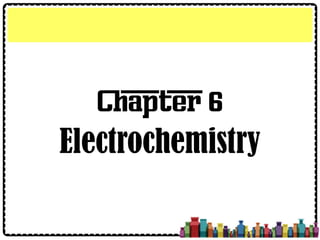
Chapter 6 Electrochemistry
- 2. A. Electrolytes & Non-electrolytes Electrolytes Substances that can conduct electricity and undergo chemical changes Non-electrolytes Substances that cannot conduct electricity
- 4. Why electrolyte at molten and aqueous state can conduct electricity? BECAUSE There presence of free moving ions in the electrolyte
- 5. B. Electrolysis of Molten Compounds Electrolysis A process where compounds in molten or aqueous state are broken down into their constituent elements by passing electricity through them
- 6. Electrolytic cell The set of apparatus needed to conduct electrolysis Electrolyte CathodeAnode + - STEPS OCCUR DURING ELECTROLYSIS Movement of ions to the electrodes. Discharges of ions at the electrodes. Graphite or platinum is usually used as electrodes because they are inert.
- 7. Important note: Observation Anode (positive electrode) Electrolysis product Observation Confirmatory test Chlorine gas Greenish-yellow gas bubbles released Place moist blue litmus paper into test tube Moist blue litmus paper turn redBromine gas Brown gas released Iodine Purple gas released Oxygen gas Colourless gas bubble released Place a glow wooden splinter near the mouth of test tube The glowing wooden splinter light up Metal (all metal) The mass of electrode decreased Copper metal Brown solid formed
- 8. Important note: Observation Cathode (negative electrode) Electrolysis product Observation Confirmatory test Almost all metal (except copper metal) Grey solid formed The mass of electrode increase No test for metals Copper metal Brown solid formed Hydrogen gas Colourless gas bubbles released Place a lighted wooden splinter near the mouth of test tube A “pop” sound heard/produced
- 9. Electrolysis of molten compound
- 10. Electrolysis of molten compound • PbBr2 • LiCl • MgBr2 • PbI2 • ZnO • CuCl2 • Molten Potassium oxide • Molten Magnesium oxide • Molten Potassium iodide
- 11. Electrolysis of Aqueous Solutions Factors that affect the electrolysis of an aqueous solution • Position of ions in the Electrochemical Series • Concentration of ions in the electrolytes • Types of electrodes used in the electrolysis
- 12. Position of ions in the Electrochemical Series • The ions that are lower in the electrochemical series will be selected discharged
- 13. K+ Na+ Ca2+ Mg2+ Al3+ Zn2+ Fe2+ Sn2+ Pb2+ H+ Cu2+ Ag+ F- SO4 2- NO3 - Cl- Br- I- OH- The Electrochemical Series Ease of discharge increases
- 14. 0.01 mol dm-3 of copper(II) sulphate using carbon as electrodes 1 mol dm-3 of copper(II) sulphate solution CarbonCarbon
- 16. Concentration of ions • If the concentration of a particular ions is high, the ions is selectively discharged TIPS: ANODE Ion selectively discharged based on CONCENTRATION of ions CATHODE Ion selectively discharged based on position of ions in Electrochemical Series
- 17. 2 mol dm-3 of hydrochloric acid, HCl using platinum as electrodes 2 mol dm-3 of hydrochloric acid, HCl PlatinumPlatinum
- 19. Types of electrodes • Electrolysis of copper(II) sulphate, CuSO4 solution using copper electrode • Electrolysis of silver nitrate, AgNO3 solution using silver electrode
- 20. 0.02 mol dm-3 of copper(II) sulphate, CuSO4 using copper as electrodes 0.02 mol dm-3 of copper(II) sulphate, CuSO4 CopperCopper
- 22. 0.02 mol dm-3 of silver nitrate, AgNO3 using silver as electrodes 0.02 mol dm-3 of silver nitrate, AgNO3 SilverSilver
- 23. D. Electrolysis in Industries • The most industrial application of electrolysis: 1. extraction 2. purification 3. electroplating of metals
- 24. E. Voltaic Cells • Chemical energy to electrical energy • Examples of chemical cell: simple voltaic cell Daniell cell dry cell alkaline cell lead-acid accumulator
- 25. Simple Voltaic Cell Two different metals being immersed into an electrolyte and connected by wire V
- 26. Daniell cell – has two types • Use porous pot • Use salt bridge
- 27. Use porous pot
- 28. Use salt bridge
- 29. F. The Electrochemical Series • The Electrochemical Series is series of element, arranged according to the order of decreasing tendency to released electrons. • Or the greater the tendency to donate electrons, the more electropositive is the metal and the higher it is in the Electrochemical Series.
- 30. Principles Used: • Metals are arranged according to the tendency of their atoms to release electron. • More the tendency of their atoms to release electron, the higher located it is in the series. • Elements located at HIGHER part of the Electrochemical Series are more electropositive and have higher tendencies to release electrons to form positive ions. • Example : magnesium is more electropositive than copper in Electrochemical Series
- 31. The Electrochemical Series can be constructed based on: Metals are arranged according to their tendency to release electrons to form positive ion (cation). • metal has a higher tendency to release electron placed a the higher position in Electrochemical Series. • the metal act as negative terminal
- 32. The ability of a metal to displace another metal from its salt solution. • If metal is able to displace another metal from its salt solution, this metal is placed at the higher position in Electrochemical Series
- 33. The potential difference between two metals. • The further apart between two metals in the Electrochemical Series, the greater the potential difference between them. • The greater the voltage produced by the cell.